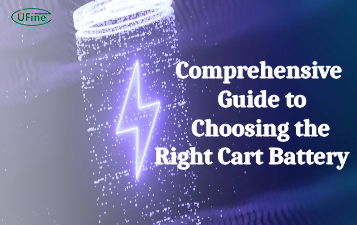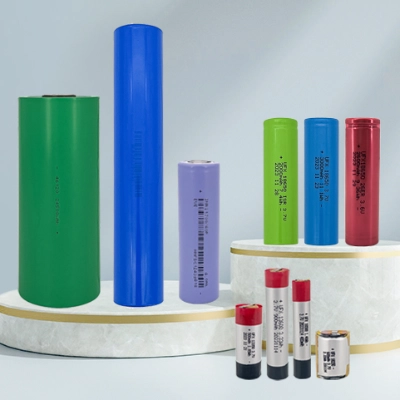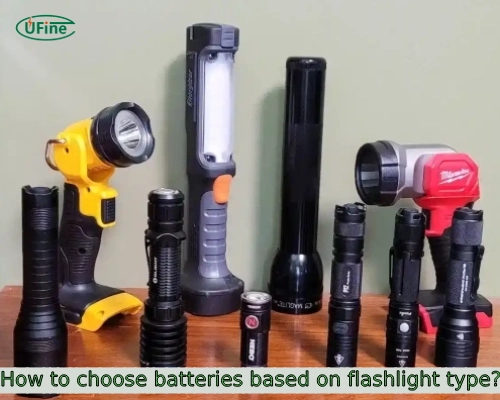Flashlight batteries play a crucial role in powering our trusty illumination devices. Whether exploring the great outdoors or preparing for a power outage, having the correct battery for your flashlight is essential. In this comprehensive guide, we will delve into the world of flashlight batteries, exploring the main types available, choosing the correct battery, discussing critical factors to consider when purchasing, offering insights on selecting batteries based on flashlight type, and sharing valuable tips for maintaining your flashlight batteries.
Part 1. What are the main types of flashlight batteries?
Flashlight batteries come in different types, each with characteristics and performance attributes. Let’s take a closer look at the main types:
1. Alkaline Batteries
Alkaline batteries are widely available and commonly used in flashlights. They are affordable and offer a good balance between performance and cost. Alkaline batteries provide a steady power supply, making them suitable for everyday flashlight usage. However, they may not perform optimally in extreme temperatures or high-drain devices.
2. Lithium Batteries
Lithium batteries are known for their exceptional performance and longevity. They offer higher energy density, allowing flashlights to produce brighter light and last longer. Lithium batteries are also lightweight, making them ideal for portable flashlights. They perform well in low and high temperatures, making them suitable for outdoor activities in various climates. However, they tend to be more expensive than alkaline batteries.
3. Nickel-Metal Hydride (NiMH) Batteries
NiMH batteries are rechargeable and offer a greener alternative to disposable batteries. They have a higher capacity than alkaline batteries. They can be recharged multiple times, reducing waste and cost in the long run. NiMH batteries are suitable for flashlights used frequently or for extended periods. They have a lower self-discharge rate than nickel-cadmium (NiCd) batteries, meaning they retain their charge for more extended periods of inactivity.
4. Nickel-Cadmium (NiCd) Batteries
While NiCd batteries were popular in the past, they have become less common due to their lower capacity and memory effect, which causes a decrease in battery performance over time. Despite this, they still find some applications in older flashlight models.
Part 2. Choosing the right battery for your flashlight
Battery Chemistry Comparison:
When picking the perfect battery for your flashlight, it’s essential to understand the various battery chemistries available. Let’s break down the pros and cons of some common types:
Alkaline Batteries:
- Pros: Widely available, affordable, and suitable for general use.
- Cons: Limited lifespan, especially in high-drain devices like flashlights.
Lithium Batteries:
- Pros: Lithium batteries offer several advantages, including high energy density, longer shelf life, and better performance in extreme temperatures.
- Cons: A downside of lithium batteries is that they are typically more expensive than alkaline batteries.
NiMH (Nickel-Metal Hydride) Batteries:
- Pros: Rechargeable, environmentally friendly, and perform well in moderate to high-drain devices.
- Cons: A disadvantage of NiMH (Nickel-Metal Hydride) batteries is their lower energy density than alkaline and lithium batteries.
Considerations for Flashlight Compatibility:
When choosing batteries for your flashlight, it’s crucial to consider the following factors to ensure compatibility:
- Size: Make sure the batteries fit snugly into your flashlight’s battery compartment without any issues. Check the dimensions and compare them with the specifications provided by the flashlight manufacturer.
- Voltage Requirements: Verify the voltage requirements of your flashlight to ensure compatibility with the selected batteries. Using batteries with the wrong voltage can damage your flashlight or affect its performance.
- Compatibility with Battery Holders: Some flashlights may require specific types of battery holders or adapters to accommodate certain battery sizes or chemistries. Ensure that the batteries you choose are compatible with the flashlight’s battery holder or adapter, if applicable.
Part 3. Factors to consider when buying flashlight batteries
Factors to Consider When Buying Flashlight Batteries
- Battery Type: Understand the different types of batteries available for flashlights, including alkaline, lithium, and NiMH. Each type has advantages and disadvantages, so choose one that aligns with your needs and preferences.
- Size and Fit: Ensure your select batteries are compatible with your flashlight’s battery compartment. Check the batteries’ size and dimensions to ensure they fit properly without any issues.
- Voltage Compatibility: Verify the voltage requirements of your flashlight and select batteries that meet or exceed these requirements. Using batteries with the wrong voltage can damage your flashlight or compromise performance.
- Capacity: Consider the capacity of the batteries, which determines how long they can power your flashlight before needing to be replaced or recharged. Higher-capacity batteries typically last longer, making them ideal for extended use.
- Shelf Life: Evaluate the shelf life of the batteries, especially if you plan to store them for long periods or use them infrequently. Lithium batteries generally have a longer shelf life than alkaline batteries, making them a better choice for emergency preparedness.
- Performance in Different Conditions: Consider how well the batteries perform in various environmental conditions, such as extreme temperatures or high humidity. Lithium batteries are known for superior performance compared to alkaline batteries in extreme conditions.
- Rechargeability: Decide whether you prefer disposable or rechargeable batteries for your flashlight. Rechargeable batteries may require an initial investment in a charger. Still, they can be more cost-effective and environmentally friendly in the long run.
Part 4. How to choose batteries based on flashlight type?
Tailor your battery selection to suit the specific flashlight type:
1. Compact Flashlights
Compact flashlights, often used for everyday tasks, require batteries that balance size and performance well. People often use alkaline batteries in compact flashlights because they are affordable and readily available. However, lithium batteries can be a suitable choice if you prioritize longer battery life and brighter light output.
2. Tactical Flashlights
Manufacturers design tactical flashlights for professionals and outdoor enthusiasts who require reliable, high-performance lighting. These flashlights often have higher power requirements and can benefit from lithium batteries. Lithium batteries offer superior performance, longer runtime, and better resistance to extreme temperatures, making them ideal for demanding situations.
3. Rechargeable Flashlights
Rechargeable flashlights provide a sustainable and cost-effective solution. When choosing batteries for rechargeable flashlights, opt for NiMH or lithium batteries. NiMH batteries are readily available and offer the convenience of recharging multiple times. Lithium batteries, although typically more expensive, provide longer battery life and better performance, making them a valuable investment for rechargeable flashlights.
4. Headlamps
Headlamps are famous for hands-free illumination during outdoor activities like camping or hiking. People commonly use alkaline batteries in headlamps because they are affordable and easy to find. However, lithium batteries can be a suitable alternative if you require more extended battery life and lighter weight. They provide brighter light output and last longer, ensuring a reliable light source during extended adventures.
Part 5. Tips for Maintaining Flashlight Batteries
1. Store Batteries Properly
Store your batteries in a cool, dry place when not in use. Avoid exposing them to extreme temperatures, affecting their performance and lifespan. Consider using a battery organizer or case to keep them organized and protected.
2. Remove Batteries During Long Periods of Inactivity
If you don’t use your flashlight for an extended period, remove the batteries to prevent leakage or corrosion. This precautionary measure helps preserve the battery lifespan and ensures they are ready for use when needed.
3. Clean Battery Contacts
Regularly clean the battery contacts of your flashlight to remove any dirt, dust, or corrosion. Use a clean cloth or a cotton swab dipped in rubbing alcohol to clean the contacts gently. This ensures good electrical conductivity and helps maintain optimal performance.
4. Avoid Deep Discharging
Try to avoid fully discharging your batteries before recharging or replacing them. Deep discharging can negatively impact battery performance and lifespan. Instead, recharge or replace batteries when they reach around 20-30% of their capacity to maintain their longevity.
Part 6. FAQs
-
What is the correct way to put batteries in a flashlight?
First, remove the battery compartment cover to insert batteries into a flashlight. Then, align the positive and negative ends of the batteries with the corresponding markings inside the compartment. Insert the batteries firmly, ensuring they are in the correct orientation, and securely replace the battery compartment cover. -
What is the best battery chemistry for flashlights?
The best battery chemistry for flashlights depends on your specific needs and usage. However, many prefer lithium batteries for their high energy density, longer shelf life, and better performance in extreme temperatures than alkaline batteries. -
Is lithium or alkaline better for a flashlight?
Lithium batteries are generally considered better for flashlights due to their higher energy density, longer shelf life, and superior performance in extreme conditions. Alkaline batteries, while widely available and less expensive, may have shorter lifespans and lower performance in high-drain devices like flashlights. -
What size battery is in a flashlight?
The size of the battery in a flashlight can vary depending on the specific model and design. Standard sizes include AAA, AA, C, and D batteries. It’s essential to check the flashlight’s specifications or refer to the battery compartment for the required size.
Related Tags:
More Articles

Comprehensive Guide to Choosing the Right Cart Battery
Choosing the right cart battery ensures optimal performance and longevity. This guide covers cart battery types and helps you make an informed choice.
The Ultimate Guide to 18650 Button Top Battery
18650 button top batteries are popular for their high energy density and reliability. This guide covers their key features, usage, and maintenance tips.
The Power of Slim: Unveiling the Potential of Flat Lithium Ion Battery
Flat lithium-ion batteries power devices from phones to vehicles. This article explores their design, benefits, types, applications, charging, and safety.
The Comprehensive Guide to Battery Balancing and Battery Balancer
Battery balancing and balancers optimize performance, longevity, and safety. This guide covers techniques and tips for choosing the right balancer.
10 Key Facts About Drone Battery for 2024
Uncover crucial insights with "10 Key Facts About Drone Battery for 2024." Learn the latest trends and essential details on drone batteries.





